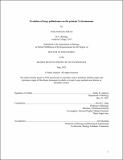Evolution of large palindromes on the primate X chromosome
Author(s)
Jackson, Emily Katherine
DownloadThesis PDF (19.79Mb)
Advisor
Page, David C.
Terms of use
Metadata
Show full item recordAbstract
Human sex chromosomes are enriched for complex genomic architecture, including massive palindromes with arms that can exceed 1 Mb in length and arm-to-arm sequence identity higher than 99%. Palindrome arms harbor protein-coding genes with testis-biased expression, suggesting roles in male fertility. However, palindromes are under-represented in non-human reference genomes due to technical challenges associated with genomic repeats, limiting our understanding of palindrome origins and evolution.
In this thesis, we used specialized methods to investigate the evolution of X-chromosome palindromes in primates. We used a clone-based sequencing approach that incorporates ultralong nanopore reads to generate accurate reference sequence for regions orthologous to human X palindromes in two non-human primates, the chimpanzee and the rhesus macaque. Twelve human X palindromes have conserved orthologs in both species, demonstrating a common origin at least 25 million years ago. The majority of these palindromes were missing or misassembled in existing reference genomes for these species. Comparative analyses demonstrate that natural selection preserves X-palindrome gene families, despite limited functional characterization of these genes in humans. Unexpectedly, structural comparisons of conserved palindromes between species revealed frequent rearrangements around the center of palindrome symmetry; this instability persists among human X chromosomes, which are enriched for deletions within the spacer that separates palindrome arms.
Sequence identity between palindrome arms is maintained by high rates of intra-chromosomal gene conversion, which led us to hypothesize that palindromes may be subject to amplified effects from GCbiased gene conversion. Among twelve conserved primate X palindromes, we find that palindrome arms are significantly more GC-rich than flanking sequence, and that GC content in primate X-palindrome arms is increasing over time. Evolutionary simulations reveal that nucleotide replacement patterns between species are consistent with a magnitude of GC bias in gene conversion of around 70%, consistent with previous estimates derived from analyses of human meiosis. Altogether, the work presented in this thesis demonstrates an unexpectedly deep evolutionary history of primate X palindromes that is shaped by a complex mixture of natural selection, localized structural instability, and GC-biased gene conversion.
Date issued
2021-06Department
Massachusetts Institute of Technology. Department of BiologyPublisher
Massachusetts Institute of Technology